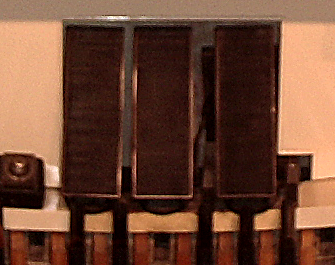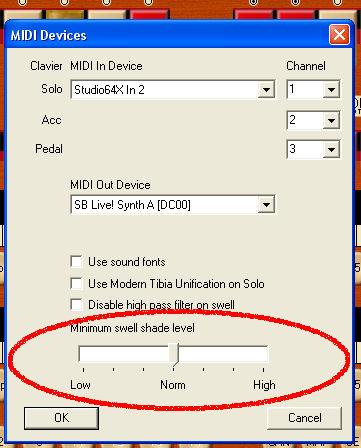| The
MiditzerTM Console The Swell Shoe... |
|||
THE MIDITZER The Console Tech Session ELSEWHERE
|
Organ pipes always play at the same
volume. The volume is controlled by swell shades placed between
the organ pipes and the audience. Swell shades look like giant
wooden shutters. They can be opened and closed by the "gas pedal"
or swell shoe on the organ console. The picture below shows the
swell shoes of the Orpheum's Style 240 console. The Style 216 has
the same arrangement. There is one swell shoe for each pipe
chamber. In the 216 and 240, which have two pipe chambers, there
are two swell shoes. These are the two leftmost pedals.
The
rightmost pedal is the crescendo. The crescendo pedal adds stops
as it
is pressed down, which is another way to increase the volume of an
organ. The crescendo pedal is slightly raised so the organist can
distinguish it from the swell shoes by feel. The swell and
crescendo pedals are controlled with the right foot. The right
foot may also be needed to play upper pedal notes so it has to be able
to find its way over a lot of territory. Most often the organist
will control both chambers together by centering the right foot
on the two swell pedals. On larger organs with more than two
chambers, there will be additional swell pedals. On such organs,
there is usually a general swell shoe just to the left of the crescendo
to control all the swell shades together. If you have a
MIDI controller that generates MIDI
Controller Change Messages for any of Controller 11, Controller 7, or
Controller 1 (Mod Wheel) it will controll the expression (volume) in
the Miditzer. This simulates the effect of using both swell shoes
together. There is no crescendo pedal available in the Miditzer
at this time. Effective use of the swell pedal adds considerably
to a theatre organ performance. When the swell
shades are fully closed they reduce the sound but the organ is still
quite audible. Therefore, the Miditzer does not send a zero
volume message to the MIDI synthesizer when the MIDI expression is at
zero. You can adjust the minimum volume level for the zero
expression input in the MIDI Devices dialog:
The swell shades
reduce high frequencies more effectively than low frequencies. As
the swell shades open the organ will get brighter as well as
louder. The Miditzer sends signals to sound font devices to
simulate this effect by altering the high pass filter setting of the
synthesizer. This works well with the Bruce Miles' cinema organ
sound font. It may interfere with the use of other sound fonts
that use the high pass filter for other purposes. The high pass
filter can be disabled for such sound fonts.
Last
update 10/24/2004
© 2004 Jim Henry All Rights Reserved
|



